The most well-known form is the fist -- the fingers are all curled in as tightly as possible, and the thumb is folded down over the second row of phalanges.
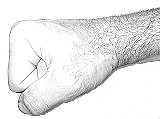

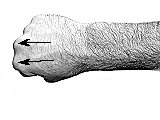
 The Shuai Chiao Kungfu Club at The Ohio State
University (return)
The Shuai Chiao Kungfu Club at The Ohio State
University (return) General Hints for Hand Training:
Take it slowly: don't rush body-hardening or toughening practice! Punching with even a simple fist can damage the untrained hand. It takes several weeks for the external flesh to toughen, months for the tendons and bones. It is very easy to rip the skin off the knuckles when first practicing, and easy to sprain the wrist or finger joints when striking a solid object without the proper alignment. Whenever an open wound or bruise is created, the hand must be protected and healed before full training can begin again. Your hands are precious tools for coping with the world -- don't abuse them by trying to quickly transform them into powerful blunt weapons. True "iron-hand" training requires a specific training sequence, equipment, and proper medicines and liniments. It should not be attempted without full information and guidance from a skilled practitioner. Moderate toughening exercise, however, can be safely done with minimal instruction.
Start with light but frequent practice. The biggest mistake beginners (and some "advanced" students) make is to try and fit months of conditioning into a couple of weeks or days. Start with a small but firm target: an old telephone book works well. Prop it up on a chair or couch, and lightly punch or strike it with the hand-form you are training. Don't practice striking more than five or ten minutes, or until the knuckles are slightly red. Immediately afterward, give them and the rest of the hand a gentle massage to encourage more circulation. Striking lightly, but firmly, will give you immediate feedback in your hand, wrist and arm as you find the proper alignment of the joints. While going about daily routines and tasks, continue your light training: push open doors, etc. with the knuckles of your closed fist instead of a palm.
Do not train the fingertips on hard objects. The tips of the fingers are very sensitive and several acupuncture meridians terminate there. The Chinese say that hard training on the fingertips without careful preparation and restorative medication can result in poor health and weaker vision.
The Simple Fist:
The most well-known form is the
fist -- the fingers are all curled in as tightly as possible, and the thumb
is folded down over the second row of phalanges.



The striking surface is the major knuckles: the ends of the metacarpal bones of the index and middle fingers (arrows).
It is important to keep the wrist aligned with the two major metacarpals so that the force goes directly through them without any torque or side force being applied to the wrist bones. Generally, when a punch is delivered, the wrist is straight. The simple fist may be delivered two ways: with the wrist vertical (a standing, or vertical fist), or with the wrist horizontal (a flat, or overturned fist). The general consensus is that the vertical fist is slightly stronger biomechanically. However, if the fist is "screwed" into the horizontal position at the moment of impact it can create a vortex or twisting effect through the body structure and fluids resulting in a more penetrating strike.
It is important to make sure that the force of the punch is expressed through the two major metacarpals. If the ring and little finger metacarpals are brought into contact, they may be broken due to their much smaller size ("boxer's fracture").
A major modification is the Motobu Fist.
The Open Hand:
The second major hand form is the open palm, the infamous
"karate chop," known as the shuto or "knife hand" in Okinawan styles.
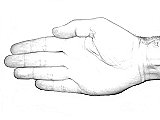
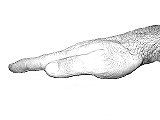 The Lotus Palm
The Lotus Palm
This form of the hand is generally known in Kungfu as
a "lotus palm", with the thumb outstretched along the fingers. If
the thumb is cocked tightly in a fist form position, it is known as the
"willow palm". While this hand form can be used directly, either thrusting
with the fingertips or striking with the little finger edge of the palm,
it is more commonly used in Shuai Chiao in the "standing palm" form.
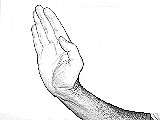 The Standing, or "Willow"
Palm
The Standing, or "Willow"
Palm
Here, the little finger edge of the palm is used to press
on and attack specific acupuncture points, as in the basic "Chopping Throw",
or used as a general blocking and parrying technique to draw the opponent's
extended limb into a grasping hold. The Open Palm hand is much used
in Shuai Chiao: by placing the fingers and thumb together, the hand becomes
a unified object that is quite resilient to strikes and blows. If
the fingers and thumb are separated, it is very easy to have a finger "snagged"
by an opponent's kick or punch, resulting in a sprained or broken finger.
By keeping the fingers and thumb together the flexiblity, softness, and
sensitivity of an "open-hand" style can be maintained while still having
a robust hand-form that can withstand a direct strike.
A variation of the willow palm is the "corrugated palm",
much used in the Tai-zu style as an attacking hand-form. Here, the
hand is arched across both its width and length and somewhat tensed to create
a stronger striking weapon.
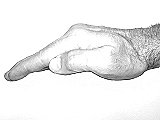 The Corrugated Palm
The Corrugated Palm
With this hand form, the fingertips have more support,
and the back of the hand arches the major metacarpals into action for offensive
or defensive strength.
The Hooking Hand:
A signature hand-form of the Crane and Praying Mantis styles is the hook.
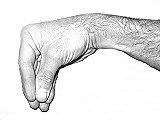 Crane Style hook
Crane Style hook 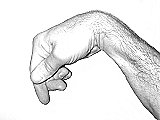 Mantis Style hook
Mantis Style hook
These hand-forms are usually used in a defensive manner,
to parry, hook, and ensnare an opponent's attack. However, the tips
of the hook, especially in the Crane form, can be used to deliver a powerful
"pecking" attack with the tips of all five fingers. When the hand
is strongly hooked (as in the Mantis Style above), the top of the wrist can
be used to deliver a powerful blunt strike.
If the elbows are kept low and close to the body, the hook hand-form alone, without the thumb, can grasp an opponent's wrist with enough power to drag him into a counter-attacking strike or throw.
The Claws:
 Tiger Claw
Tiger Claw  Eagle Claw
Eagle Claw
The clawing techniques use the power of the individual
fingers to rake or grasp the opponent. The Tiger Claw is a general
open claw, used to attack the soft parts of the opponent: the eyes and throat.
The Eagle Claw is more tensed and tight: it can grasp and penetrate the muscles
of the arms and the joints of the body.
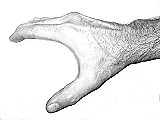 The Tiger's Mouth
The Tiger's Mouth
This hand-form keeps the fingers together but separates the thumb to create a strong pincher. This is the form used in the Shuai Chiao stance, "Supporting the Sky", where the upper hand blocks and grabs the opponent's arm, while the lower hand attacks the opponent's throat or side. The inverted form, with the palm facing up, was used often by Grandmaster Ch'ang as a receiving parry to an opponent's leading arm, pulling the opponent into the Leading Arm Kick or Knee Seizing throws.
 The Ginger Fist
The Ginger Fist
This fist is used to focus the attacking force on the
knuckles of the first phalanges, or finger bones. While weaker than
the regular fist, the narrow attacking surface can penetrate and separate
more effectively. This form is used to attack softer, deeper, targets
such as the throat, organs, and acupuncture points, or used as a splitting
force in attacking the floating ribs.
 Thumb Fist
Thumb Fist  Phoenix Fist
Phoenix Fist
Like the Ginger Fist, the Thumb and Phoenix fists use the fingers to produce a smaller striking point. In the Thumb Fist it is the tip of the thumb itself. The Phoenix (or Phoenix Eye) Fist uses the knuckle of the middle finger (shown), or the knuckle of the index finger. The Phoenix fist is often used in a twisting, "drilling" fashion to attack specific pressure points.
It is very important to note that such specialized fist forms, and the fingertip strike techniques of the Lotus Palm, require considerable training to toughen the smaller bones and joints of the fingers before trying to use them in combat.
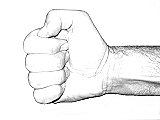 Isshinryu Fist
This is an Okinawan variant, devised by Tatsuo Shimabukuro, founder of the
Isshinryu Style. The thumb is protected by locking
it on top of the index finger. Proponents claim that this form stiffens
and supports the wrist as well.
Isshinryu Fist
This is an Okinawan variant, devised by Tatsuo Shimabukuro, founder of the
Isshinryu Style. The thumb is protected by locking
it on top of the index finger. Proponents claim that this form stiffens
and supports the wrist as well.
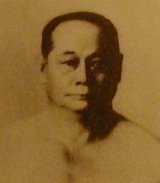 Choki Motobu was a famous Okinawan
karate master in the early and middle 1900's. He was most well known
for his dedication to the mastery of the simple makiwara, the Okinawan punching
board. In his practice, he came up with a slight modification of the
standard way of forming a simple fist, which is now known amongst karateka
as the "Motobu Fist".
Choki Motobu was a famous Okinawan
karate master in the early and middle 1900's. He was most well known
for his dedication to the mastery of the simple makiwara, the Okinawan punching
board. In his practice, he came up with a slight modification of the
standard way of forming a simple fist, which is now known amongst karateka
as the "Motobu Fist".
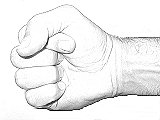
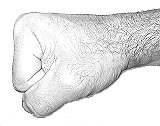 In this variation, the index finger is folded straight down, and not
curled under with the other fingers. The advantages are twofold:
the fist becomes smaller and tighter with the index finger moving back
to allow the index knuckle to protrude, and the thumb is now backed up
and supported by the folded index finger. If a regular fist is struck
directly on the thumb, the thumb can be instantly pushed back into the hollow
of the fist and dislocated or broken. With the Motobu fist, the thumb
is well braced by the second and first bones of the index finger, and can
endure much more force without damage.
In this variation, the index finger is folded straight down, and not
curled under with the other fingers. The advantages are twofold:
the fist becomes smaller and tighter with the index finger moving back
to allow the index knuckle to protrude, and the thumb is now backed up
and supported by the folded index finger. If a regular fist is struck
directly on the thumb, the thumb can be instantly pushed back into the hollow
of the fist and dislocated or broken. With the Motobu fist, the thumb
is well braced by the second and first bones of the index finger, and can
endure much more force without damage.
The only real disadvantage of the Motobu fist is the extra effort in forming it correctly. With enough practice, it will become just as fast and automatic as a regular fist. We highly recommend this variation of the simple fist, especially for students with larger fingers who have a hard time making a regular fist tight enough to hit with the front knuckles instead of the fingers.
 The Shuai Chiao Kungfu Club at The Ohio State
University (return)
The Shuai Chiao Kungfu Club at The Ohio State
University (return)